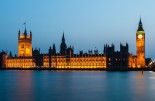AXA IM: BoE increases QE by £100bn amidst ongoing COVID uncertainty
AXA IM: BoE increases QE by £100bn amidst ongoing COVID uncertainty

David Page, Head Macro-Research at AXA Investment Managers, comments on the latest decisions of the Bank of England.
- The BoE left Bank Rate unchanged at 0.10% as expected.
- The BoE extended its QE program by £100bn, implying a pace of £4bn per week over H2 2020, this was in line with consensus but a little less than our expectation of £125bn QE and £5bn per week.
- Chief Economist, Andy Haldane, dissented from the rest of the Committee preferring to leave policy unchanged.
- The minutes made no mention of negative interest rates being considered.
- Minutes stressed uncertainty over the economic outlook, suggesting that the drop in activity might be “less severe”, but that this did not necessarily suggest an improved medium-term outlook.
- BoE policy accommodation through the rest of this year looks appropriate for now, but we expect a further extension (£75bn) of QE in November’s Monetary Policy Meeting – albeit acknowledging that we will know much more by that stage.
The Bank of England announcement today left Bank Rate unchanged at 0.1%, but increased its QE by £100bn, raising the Asset Purchase Facility to £745bn from £645bn. This was in line with market consensus, but below our own forecast of £125bn. The Bank suggested this would see the scheme through until around the end of the year. Our own forecast had been predicated on a slowing of the weekly pace of purchases to £5bn per week from the current pace of £13.5bn. The BoE announcement suggests this will slow further to £4bn per week. It also suggested that the corporate bond purchase would not be extended beyond the current £10bn at this stage. However, the MPC saw one dissenter with Chief Economist, Andy Haldane, voting not to extend QE by £100bn, instead preferring to maintain the current stance of policy which would have led to an ending of QE within weeks, a proposition for which markets were not prepared. In terms of policy decisions it is also worth noting that despite significant commentary, precipitated by Haldane, there was not one reference to any discussion of negative interest rates. This was consistent with more recent commentary from the Committee and Haldane that this was just a consideration at this stage. BoE Governor Bailey also sent a letter to Chancellor Sunak consistent with the MPC’s mandate as CPI inflation had fallen to 0.5% in May, below the threshold requiring explanation.
Minutes released accompanying today’s announcement went into some detail about the outlook for GDP in the face of the coronavirus shock. The minutes recorded that the Committee now envisaged the fall in global GDP as “less severe” than at the time of the May Monetary Policy Report. This, they said, had reflected an earlier easing in restrictions, but also less impact of lockdowns. This was also the case for the UK GDP outlook, where the Committee now envisioned an H1 2020 decline of 20% compared with 27% in May. However, the MPC went on to stress that despite an improved short-term outlook, “it was difficult to make a clear inference from that about the recovery thereafter”. The labour market was a clear source of uncertainty. The MPC acknowledged that the government’s CRJS furlough scheme had seen more uptake than it expected, cushioning the impact on the labour market to date. However, it argued that it was uncertain how much of these furloughed workers would be re-employed after and that the large numbers raised risks “higher and more persistent unemployment”. Accordingly, uncertainty shrouded the outlook for consumer behaviour, although the Bank acknowledged that payments data suggested that a solid rebound in May’s spending was possible. Longer-term, it worried about the impact of social-distancing and job-uncertainty related precautionary behaviour weighing on consumer spending. Meanwhile, more broadly the MPC worried that ongoing high uncertainty, weaker balance sheets and increased risk aversion could weigh on corporate spending. In conclusion, the MPC stated that “the outlook for the UK and global economies is unusually uncertain”, but that “downside risks” remain.
The BoE’s warning on the elevated uncertainty is warranted in our view, not least with significant uncertainty about what to expect next from the virus. The BoE’s assessment that GDP was likely to have contracted by 20% in H1 2020, from a previous estimate of 27%, suggests that if Q1 GDP estimates are not revised (a strong assumption) that Q2 GDP growth would contract by around 18.5%. This is somewhat better than our own forecast of -20% for Q2. We acknowledge that the scale of rebound in May will be important to the overall quarterly contraction. To our minds, there are upside risks to tomorrow’s retail sales forecast, where consensus suggests a 6.3% month-on-month increase, but our interpretation of the BRC survey suggest a surprise similar to the double-digit rebound seen in the US. The MPC was more coy of its views going further forward, based on May’s “plausible scenario” outlook for a 14% contraction in 2020 overall, the shift in the BoE’s H1 outlook alone could see the annual outlook improve to -8%, broadly in line with market consensus. However, we do not believe that such an extrapolation is implied and our own forecast for the UK GDP drop in 2020 is 9.1%.
The MPC also discussed the inflation outlook saying that it considered current weakness to persist as pandemic related shocks to oil and demand more generally weighed. However, the MPC noted that inflation expectations had been reasonably stable. In terms of the policy outlook, it was also noteworthy that the Bank reviewed the amount of borrowing undertaken by companies to date under the various loan schemes available to different businesses. It reported borrowing had totalled £76bn. In the face of much uncertainty we think the MPC’s decision to persist with QE for the rest of this year is appropriate. Our forecasts suggest for now that disinflationary pressure is likely to persist over the coming years against a backdrop of subdued global inflation expectations. Accordingly, we think that the balance of risks is tilted to the MPC choosing to extend its QE support beyond this year and for now pencil in a further £75bn of QE in November. However, much will be learnt over the next five months in terms of the path of the virus and its impact on GDP.
Market reaction was at first likely responding to a combination of modest disappointment with the scale of QE (expectations were skewed towards more than less QE), the dissent calling for no change to policy and the lack of any discussion of negative rates that had pegged short gilt rates into negative territory. The 2-year gilt yield initially rose by 8bps to 0.0%, before paring gains and falling back to -0.06%. 10-year yields similar surged to 0.25% from 0.16%, but have settled 5bps higher at 0.21%. Sterling also saw initial volatility rising by around 0.5% to both the euro and US dollar, before settling flat to the euro and down 0.2% to the dollar from levels immediately before the decision.








